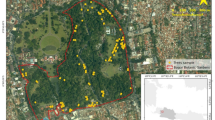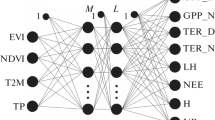Abstract
At regional to global scales the only feasible approach to mapping and monitoring forests is through the use of coarse spatial resolution remotely sensed imagery. Significant errors in mapping may arise as such imagery may be dominated by pixels of mixed land cover composition which cannot be accommodated by conventional mapping approaches. This may lead to incorrect assessments of forest extent and thereby processes such as deforestation which may propagate into studies of environmental change. A method to unmix the class composition of image pixels is presented and used to map tropical forest cover in part of the Mato Grosso, Brazil. This method is based on an artificial neural network and has advantages over other techniques used in remote sensing. Fraction images depicting the proportional class coverage in each pixel were produced and shown to correspond closely to the actual land cover. The predicted and actual forest cover were, for instance, strongly correlated (up to r = 0.85, significant at the 99% level of confidence) and the predicted extent of forest over the test site much closer to the actual extent than that derived from a conventional approach to mapping from remotely sensed imagery.
Similar content being viewed by others
References
Aleksander, I. & Morton, H. 1990. An introduction to neural com-puting. Chapman and Hall, London.
Benediktsson, J. A., Swain, P. H. & Ersoy, O. K. 1990. Neural network approaches versus statistical methods in classification of multisource remote sensing data. IEEE Trans. Geosci. Remote Sensing 28: 540-551.
Borel, C. C. and Gerstl, S. A. W. 1994. Nonlinear spectral mix-ing models for vegetative and soil surfaces. Remote Sensing Environ. 47: 403-416.
Bryant, R. G. 1995. Validated linear mixture modelling of Landsat TM data for mapping evaporite minerals on a playa surface. Pp. 729-736. Remote sensing in action. Remote Sensing Soci-ety, Nottingham.
Campbell, J. B. 1987. Introduction to remote sensing. Guilford, New Yor k.
Chauvin, Y. 1990. Generalization performance of overtrained back-propagation networks. Pp. 46-55. In: Almeida, L. B. & Wellekens, C. J. (eds) Neural networks. Springer-Verlag, Berlin
Conese, C. & Maselli, F. 1992. Use of error matrices to improve area estimates with maximum likelihood classification procedures. Remote Sensing Environ. 40: 113-124.
Congalton, R. G. 1991. A review of assessing the accuracy of classi-fications of remotely sensed data. Remote Sensing Environ. 37: 35-46.
Cox, C. B. & Moore, P. D. 1993. Biogeography: an ecological and evolutionary approach. Fifth edition. Blackwell, Oxford.
Cross, A. M., Settle, J. J., Drake, N. A. & Pävinen, R. T. M. 1991. Subpixel measurement of tropical forest cover using AVHRR data. Int. J. Remote Sensing 12: 1119-1129.
Curran, P. J., Foody, G. M., Lucas, R. M., Honzak, M. & Grace, J. 1996. The carbon balance of tropical forest: from the local to the regional scale. In: van Gardingen, P. R., Foody, G. M. & Curran, P. J. (eds) Scaling-up. Cambridge University Press, Cambridge. In press.
Czaplewski, R. L. & Catts, G. P. 1992. Calibration of remotely sensed proportion or area estimates for misclassification error. Remote Sensing Environ. 39: 29-43.
Davalo, E. & Na¨im, P. 1991. Neural networks. Macmillan, Basings-toke.
DeFries, R. S. & Townshend, J. R. G. 1994. Global land cover: comparison of ground based data sets to classifications with AVHRR data. Pp. 84-110. In: Foody, G. M. & Curran, P. J. (eds.) Environmental remote sensing from regional to global scales. Wiley, Chichester.
de Villiers, J. & Barnard, E. 1992. Backpropagation neural nets with one and two hidden layers. IEEE Trans. Neural Networks 4: 136-141.
Drake, N. & White, K. 1991. Linear mixture modelling of Landsat Thematic Mapper data for mapping the distribution and abund-ance of gypsum in the Tunisian Southern Atlas. Pp. 168-177. Spatial data 2000. Remote Sensing Society, Nottingham.
Dymond, J. R. 1992. How accurately do image classifiers estimate area? Int. J. Remote Sensing 13: 1735-1742.
Ehrlich, D., Estes, J. E. & Singh, A. 1994. Applications of NOAA-AVHRR 1km data for environmental monitoring. Int. J. Remote Sensing 15: 145-161.
Fearnside, P. M. 1988. An ecological analysis of predominant land uses in the Brazilian Amazon. The Environmentalist 8: 281-300.
Fischer, A. 1994. A model for the seasonal variations of vegetation indices in coarse resolution data and its inversion to extract crop parameters. Remote Sensing Environ. 48: 220-230.
Franklin, J. 1993. Discrimination of tropical vegetation using SPOT multispectral data. Geocarto Int. 8: 57-63.
Foody, G. M. 1995. Fully fuzzy supervised image classification. Pp. 1187-1194. Remote sensing in action. Remote Sensing Soci-ety, Nottingham.
Foody, G. M. & Cox, D. P. 1994. Sub-pixel land cover composition estimation using a linear mixture model and fuzzy membership functions. Int. J. Remote Sensing 15: 619-631.
Foody, G. M. & Curran, P. J. 1994. Estimation of tropical forest extent and regenerative stage using remotely sensed data. J. Biogeog. 21: 223-244.
Foody, G. M., McCulloch, M. B. & Yates, W. B. 1995. Classification of remotely sensed data by an artificial neural network: issues related to training data characteristics. Photogr. Eng. Remote Sensing 61: 391-401.
Goodchild, M.F. 1994. Integrating GIS and remote sensing for veget-ation analysis and modelling: methodological issues. J. Veg. Sci. 5: 615-626.
Goward, S. N., Tucker, C. J. & Dye, D. G. 1985. North-American vegetation patterns observed with the NOAA-7 Advanced Very High-Resolution Radiometer. Vegetatio 64: 3-14.
Green, G, M. & Sussman, R. 1990. Deforestation history of the eastern rainforests of Madagascar from satellite images. Science 248: 212-215.
Holben, B. N. & Shimabukuro, Y. E. 1993. Linear mixing mod-els applied to coarse spatial resolution data from multispectral satellite senors. Int. J. Remote Sensing, 14: 2231-2240.
Hlavka, C. A. & Spanner, M. A. 1995. Unmixing AVHRR imagery to assess clearcuts and forest regrowth in Oregon. IEEE Trans. Geosci. Remote Sensing 33: 788-795.
Kaufman, Y. J. Tucker, C. J. & Fung, I. 1990. Remote sensing of biomass burning in the tropics. J. Geophys. Res. 95: 9927-9939.
Kerdiles, H. & Grondona, M. O. 1995. NOAA-AVHRR NDVI decomposition and sub-pixel classification using linear mixing in the Argentinean Pampa. Int. J. Remote Sensing 16: 1303-1325.
Malingreau, J. P., Tucker, C. J. & Laporte, N. 1989. AVHRR for monitoring global tropical deforestation. Int. J. Remote Sensing 10: 855-867.
Mayaux, P. & Lambin, E. F. 1995. Estimation of tropical forest area from coarse spatial resolution data: a two step correction func-tion for proportional errors due to spatial aggregation. Remote Sensing Environ. 53: 1-15.
Milton, E. J. & Emery, D. R. 1995. The identification of reference endmembers using high spatial resolution multispectral images. Remote sensing in action. Pp. 579-586. Remote Sensing Soci-ety, Nottingham.
Mitchell, R., Martin, D., and Foody, G. 1996. Unmixing aggregate data: estimating the social composituon of enumeration dis-tricts. Pp. 613-628. Proceedings 1st International Conference on Geocomputation. School of Geography, University of Leeds, Leeds.
Nelson, R. 1989. Regression and ratio estimators to integrate AVHRR and MSS data. Remote Sensing Environ. 30: 201-216.
Pham, D. T. & Bayro-Corrochano, E. J. 1994. Self-organising neural-network-based pattern clustering method with fuzzy outputs.Pattern Recognition 27: 1103-1110.
Quarmby, N. A., Townshend, J. R. G., Settle, J. J., Milnes, M., Hindle, T. L., & Silleos, N. 1992. Linear mixture modelling applied to AVHRR data for crop area estimation. Int. J. Remote Sensing 13: 415-425.
Roller, N. E. G. & Colwell, J. E. 1986. Coarse-resolution satellite data for ecological surveys. BioScience 36: 468-475.
Rumelhart, D. E., Hinton, G. E. & Williams, R. J. 1986. Learning internal representation by error propagation. Pp. 318-362. In Rumelhart, D. E. & McClelland, J. L. (eds) Parallel distributed processing: explorations in the microstructure of cognition. MIT Press, Cambridge MA.. 154
Sampson, R. N., Apps, M., Brown, S., Cole, C. V., Downing, J., Heath, L. S., Ojima, D. S., Smith, T. M., Solomon, A. M. & Wisniewski, J. 1993. Workshop summary statement: terrestrial biospheric carbon fluxes-quantification of sinks and sources of CO2. Water, Air Soil Pollut. 70: 3-15.
Schalkoff, R. 1992. Pattern recognition: statistical, structural and neural approaches. Wiley, New York.
Sedjo, R. A. 1993. The carbon cycle and global forest ecosystems. Water, Air Soil Pollut. 70: 295-307.
Settle, J. J. & Drake, N. A. 1993. Linear mixing and the estimation of ground cover proportions. Int. J. Remote Sensing 14: 1159-1177.
Shimabukuro, Y. E., Holben, B. N. & Tucker, C. J. 1994. Frac-tion images derived from NOAA AVHRR data for studying the deforestation in the Brazilian Amazon. Int. J. Remote Sensing 15: 517-520.
Skole, D. L. 1994. Data on global land-cover change: acquisition, assessment, and analysis. Pp. 437-471. In: Meyer, W. B. & Turner II, B. L. (eds) Changes in land use and land cover: a global perspective. Cambridge University Press, Cambridge.
Skole, D. & Tucker, C. 1993. Tropical deforestation and habitat fragmentation in the Amazon: satellite data from 1978-1988. Science 260: 1905-1910.
Smith, M. O., Johnson, P. E. & Adams, J. B. 1985. Quantitative determination of mineral types and abundances from reflectance spectra using principal components analysis. J. Geophys. Res. 90: C797-C804.
Smith, M. O., Ustin, S. L., Adams, J. B. & Gillespie, A. R. 1990. Vegetation in deserts: I. a regional measure of abundance from multispectral images. Remote Sensing of Environment 31: 1-26.
Townshend, J., Justice, C., Li, W., Gurney, C. & McManus, J. 1991. Global land cover classification by remote sensing: present cap-abilities and future possibilities.Remote Sensing Environ. 35: 243-255.
Townshend, J. R. G., Justice, C. O., Gurney, C. & McManus, J. 1992. The effect of misregistration on change detection. IEEE Trans. Geosci. Remote Sensing 30: 1054-1060.
Wang, F. 1990. Fuzzy supervised classification of remote sensing images. IEEE Trans. Geosci. Remote Sensing 28: 194-201.
Wang, M. & Howarth, P. J. 1993. Modeling errors in remote sensing image classification. Remote Sensing Environ. 45: 261-271.
Williams, M. 1994. Forests and tree cover. P. 97-124. In: Meyer, W. B. & Turner II, B. L. (eds) Changes in land use and land cover: a global perspective. Cambridge University Press, Cambridge.
Williamson, H. D. 1994. Estimating sub-pixel components of a semi-arid woodland. Int. J. Remote Sensing 15: 3303-3307.
Wooster, M. J., Richards, T. S. & Kidwell, K. 1995. NOAA-11 AVHRR/2-thermal channel calibration update. Int. J. Remote Sensing 16: 359-363.
Author information
Authors and Affiliations
Rights and permissions
About this article
Cite this article
Foody, G.M., Lucas, R.M., Curran, P.J. et al. Mapping tropical forest fractional cover from coarse spatial resolution remote sensing imagery. Plant Ecology 131, 143–154 (1997). https://doi.org/10.1023/A:1009775619936
Issue Date:
DOI: https://doi.org/10.1023/A:1009775619936




